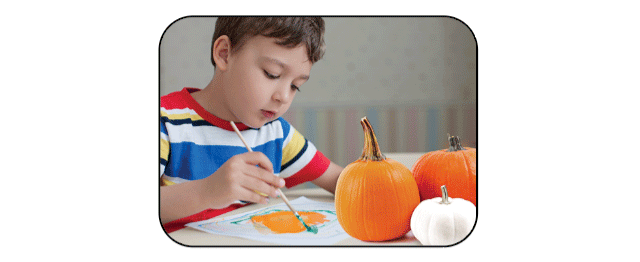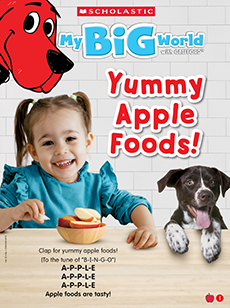A Plump and Perfect Pumpkin! Lesson Plan
What We Are Learning
Science Skills Focus:
characteristics of pumpkins
Theme Vocabulary Words:
pumpkin, peek, patch, vine, pulp, seeds, pond, float, plump
Skills We’re Practicing:
group discussion, critical thinking, vocabulary, phonological awareness/phonics, patterns
- The Legend of Spookley the Square Pumpkin by Joe Troiano celebrates the idea that great things can come from unlikely places! Spookley is a square pumpkin. At first, he does not fit in with the other pumpkins—that is, until he’s able to save the day! As you read this story with your students, ask them to think about the ways in which they are unique.
Pumpkin Seed Math
Materials: orange construction paper or paper plates, orange paint, and paintbrushes; pumpkin seeds; small cups; number cubes
- This simple counting game builds math skills with pumpkin seeds!
- Create pumpkin playing boards by cutting construction paper into pumpkin shapes. You could also use orange-painted paper plates.
- Have children work together in pairs. Give each child a game board and 6 pumpkin seeds. Give each pair a small cup to share. Have the children place their seeds in a central cup.
- To play, children will take turns rolling the number cube and placing that number of seeds on their pumpkin. When no more seeds are in the cup, players can count the seeds on their pumpkin to see who has the most.
- For an added challenge, give each student 6 more seeds! number recognition/comparing amounts

Materials: pumpkins of varying shapes, sizes, and textures; white construction paper; tempera paint; paintbrushes; black marker
- Practice observation skills while making still life pumpkin paintings!
- Place pumpkins on a table. Ask students to describe them, eliciting words like large, small, smooth, and bumpy.
- Tell students that they will make their own pumpkins like real artists. They will look closely at each pumpkin, noticing the details and textures.
- Guide your students as they use marker to draw a pumpkin. Once they’ve completed their outlines, students can use paint to add color. As they work, ask children how they will make their painting match the real pumpkin.
- Once everyone has finished, display the paintings. Have children take a gallery walk to admire each other’s artwork and discuss similarities and differences. fine-motorskills/art/observation
